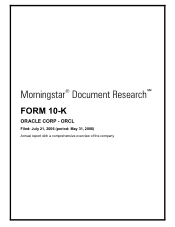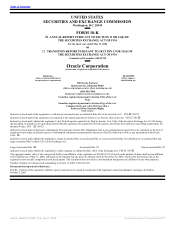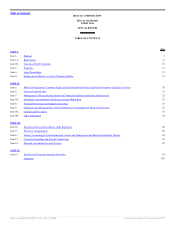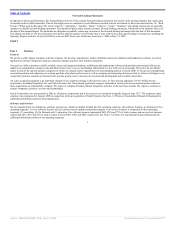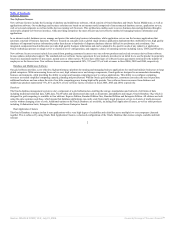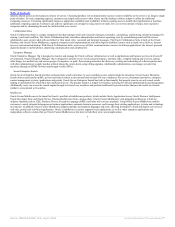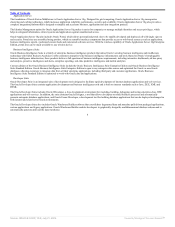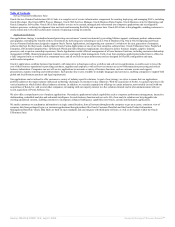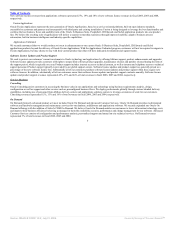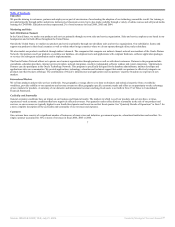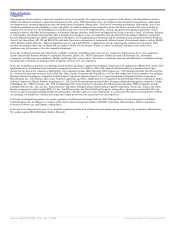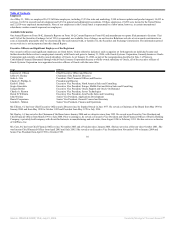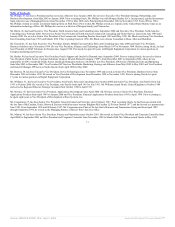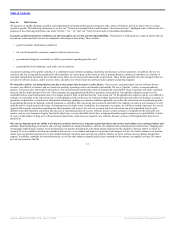Oracle 2005 Annual Report Download - page 6
Download and view the complete annual report
Please find page 6 of the 2005 Oracle annual report below. You can navigate through the pages in the report by either clicking on the pages listed below, or by using the keyword search tool below to find specific information within the annual report.
Table of Contents
database shared across an interconnected cluster of servers. Clustering database servers dramatically increases system reliability as the server is no longer a single
point of failure. To scale computing capacity, customers can simply add servers to their cluster and the database software adapts to utilize the additional
computing resources. Clustering significantly improves application scalability and availability without requiring users to modify their applications or purchase
additional computing capacity. Customers can achieve significant cost savings by using clusters of small, low-cost servers instead of larger, more expensive
computers and by eliminating the need for dedicated fail-over servers.
Collaboration Suite
Oracle Collaboration Suite is a single, integrated suite that manages email and voicemail messages, facsimiles, calendaring, conferencing, instant messaging, file
sharing, search and workflow. The Oracle Collaboration Suite centralizes administration and lowers operating costs by consolidating email and file servers.
Additionally, users are provided with one folder for their email, files, voicemail and facsimile messages. The Oracle Collaboration Suite is built on the Oracle
Database and Oracle Fusion Middleware, supports enterprise-scale implementations and offers high-availability features such as rapid server failover, disaster
recovery and automated backup. With Oracle Collaboration Suite, users access all their communications content via desktop applications, the internet, personal
digital assistants or mobile phones, improving communication and collaboration.
Enterprise Manager
Oracle Enterprise Manager 10g is designed to monitor and manage the Oracle software infrastructure as well as applications and business services in diverse IT
environments. Oracle Enterprise Manager 10g is designed to monitor service levels and performance, automate tasks, complete backup and recovery, among
other things, in a unified way and across groups of computers, or grids. Provisioning automates the discovery, tracking and scheduling of software patches and
will allow administrators to apply patches without taking the system down using rolling upgrades. Additionally, administrators can manage systems from
anywhere through an HTML browser and through wireless PDAs.
Secure Enterprise Search
Oracle Secure Enterprise Search provides an internet-like search experience to users searching secure content inside the enterprise. Oracle Secure Enterprise
Search indexes and searches public, private and shared content across internal and external web sites, databases, file servers, document repositories, enterprise
content management systems, applications and portals. Oracle Secure Enterprise Search has built-in functionality that permits users to see only search results
leading to information for which they have authorized access. The product features a simple web interface allowing for efficient administration and management.
Additionally, users can access the search engine through web-based user interfaces and perform traditional keyword searches that provide results in a format
similar to conventional web searches.
Middleware
Oracle Fusion Middleware is the brand for Oracle’s portfolio of middleware products, which include Oracle Application Server, Oracle Business Intelligence,
Oracle Developer Suite and Oracle Service Oriented Architecture Suite, among others. Oracle Fusion Middleware’s hot-pluggable architecture is built on
industry standards such as J2EE, Business Process Execution Language (BPEL) and other web services standards. Using Oracle Fusion Middleware enables
customers to easily integrate heterogeneous business applications, automate business processes, and leverage their existing applications, systems and technology
investments. In addition, Oracle Fusion Middleware supports multiple development languages and tools, allowing developers to build and deploy web services,
web sites, portals and web-based applications. Oracle’s middleware is used to support Oracle applications, as well as other enterprise applications and
independent software vendors that use Oracle Fusion Middleware as the basis to build their own custom applications.
3
Source: ORACLE CORP, 10-K, July 21, 2006 Powered by Morningstar® Document Research℠

